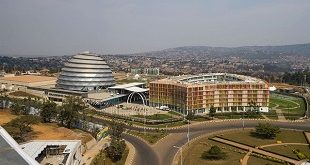
Nyiragongo: Because it can erupt any time, residents and the government must have a plan
Kigali, Rwanda | KELLY RWAMAPERA | The Nyiragongo Mountain in eastern DR Congo is a spectacle to behold. Standing at 3,470 metres high (slightly lower than Mt. Elgon which is Uganda’s second highest mountain in eastern Uganda), its soaring majesty commands the horizon even to the people across the border in Rwanda which is 20kms away. During the day people in western Rwanda often watch Nyiragongo in its glory. But what happens at night is what worries them most as the mountain top appears to be on fire.
That is because Nyiragongo has a crater which is about 2kms wide and in that crater is a lava lake; which is like a large bowl of red hot boiling melted rock called magma. Nyiragongo is the largest and most voluminous lava lake in the world.
Nyiragongo is also one in the chain of 8 volcanoes in the rift valley between Rwanda and the Democratic Republic of Congo (DRC). Two of the eight (Nyiragongo and Nyamulagira) in Eastern Congo are still very active “fire breathing” mountains.
This lake of hot molten rock has a tendency to rise and fall or, as scientists call it, inflation and deflation. Whenever this happens, according to the scientists, it cause tremors and land deformation on the mountain and scientists warn these could indicate that rocks beneath the volcano are being displaced mainly by the magma.
Rwanda scientists now warn of potential eruption of Nyiragongo.
When Nyiragongo last erupted on January 17, 2002, the lava lake had risen up to 700 metres high.
It happened in the early hours before morning, and people in the neighbouring Goma city of DR Congo who were still in bed were caught unawares. Up to 100 people were killed; mainly buried in their houses by the flowing hot magma and smoke. Another 400,000 people fled to the neighbouring Rubavu and across the border into Rwanda.
According to the Ministry of Disaster Management and Refugees Affair (MIDMAR), Nyiragongo has a large quantity of magma stored in the mountain.
Experts have it that the magma volume in Nyiragongo volcano is at 11 million cubic metres.
To understand how much this magma is, Dominique Murekezi, an engineer at Water and Sanitation Corporation (WASAC), gives examples of Akagera and Nyabarongo rivers. River Akagera pours 17 million cubic metres a day into Lake Victoria while River Nyabarongo flows at 6 million cubic meters a day.
It means that if Nyirangongo were to flow like Akagera, it would flow for 12 hours non-stop, and if it were to flow like Nyabarongo, it would take 48 hours before it becomes empty.
The experts say it is not known when “the beast shall reawaken” but it is certain that the mountain shall someday breathe fire. And, they add, there is enough evidence of an impending eruption.
“There have been 150 quakes recorded in the area of Nyiragongo since 2016 and most of them came in a seismic swarm (many tremors in a short period of time) in October 2017,” says Philippe Habinshuti, the director of the Response and Recovery unit at MIDMAR.
According to scientific data, earth tremors around an active volcano mean movement of magma beneath, displacing rocks as it gets near to the surface. This is the lava that is spewed out when the volcano erupts.
Preparing for the worst
According to MIDMAR, an earthquake of magnitude 6.0 (bigger than the Bukoba Tanzania earthquake of September 2016) can trigger the expected eruption from Nyiragongo Mountain.
During the 2002 eruption, the Rwanda government was caught off guard. The same happened in 1977. This time it is putting in place the necessary intervention arrangements to be on a safer side.
“In 2002, we were not prepared to receive huge numbers of displaced people on Rwanda side. It was, therefore, hard for the country to evacuate, while there were unexpected high traffic flows and the main road was blocked,” Habinshuti noted.
“Since we cannot know when a huge earthquake can strike, we have to always be prepared to receive the people in case the mountain erupts,” Habinshuti elaborated.
Already, responsibilities have been distributed and assigned among all concerned sectors, including security organs, local government authorities, ministries, and government partners.
“We expect roughly 600,000 displaced people: 550,000 from our neighbours in DR Congo and 50,000 from Rwanda” said Jean Baptiste Nsengiyumva, the director of the Risk Reduction and Preparedness Unit.
He added that over 260 hectares of land were available in case the mountain erupted and an estimated Rwf15 billion will be needed to facilitate relief interventions.
Methane power project risk
The experts have also been considering a scenario that could have even graver consquences; if magma from the Nyiragongo volcano reaches the methane gas in neighbouring Lake Kivu.
According to this scenario, this could cause a massive methane gas explosion. Fortunately, the experts say, there is a distance of more than 20 kilometres from Nyiragongo to the deep waters of Lake Kivu where methane gas is.
“Even if the eruption is triggered by a bigger earthquake, lava cannot travel all that way into Lake Kivu. And, even if it does, it will be cold before it reaches methane gas point that is about over 5 kilometres off-shore,” says Habinshuti.
And finally, although this rift valley fracture zone is very prone to earthquakes, there is no record of more than 5 magnitude earthquake ever recorded.
 The Independent Uganda: You get the Truth we Pay the Price
The Independent Uganda: You get the Truth we Pay the Price



